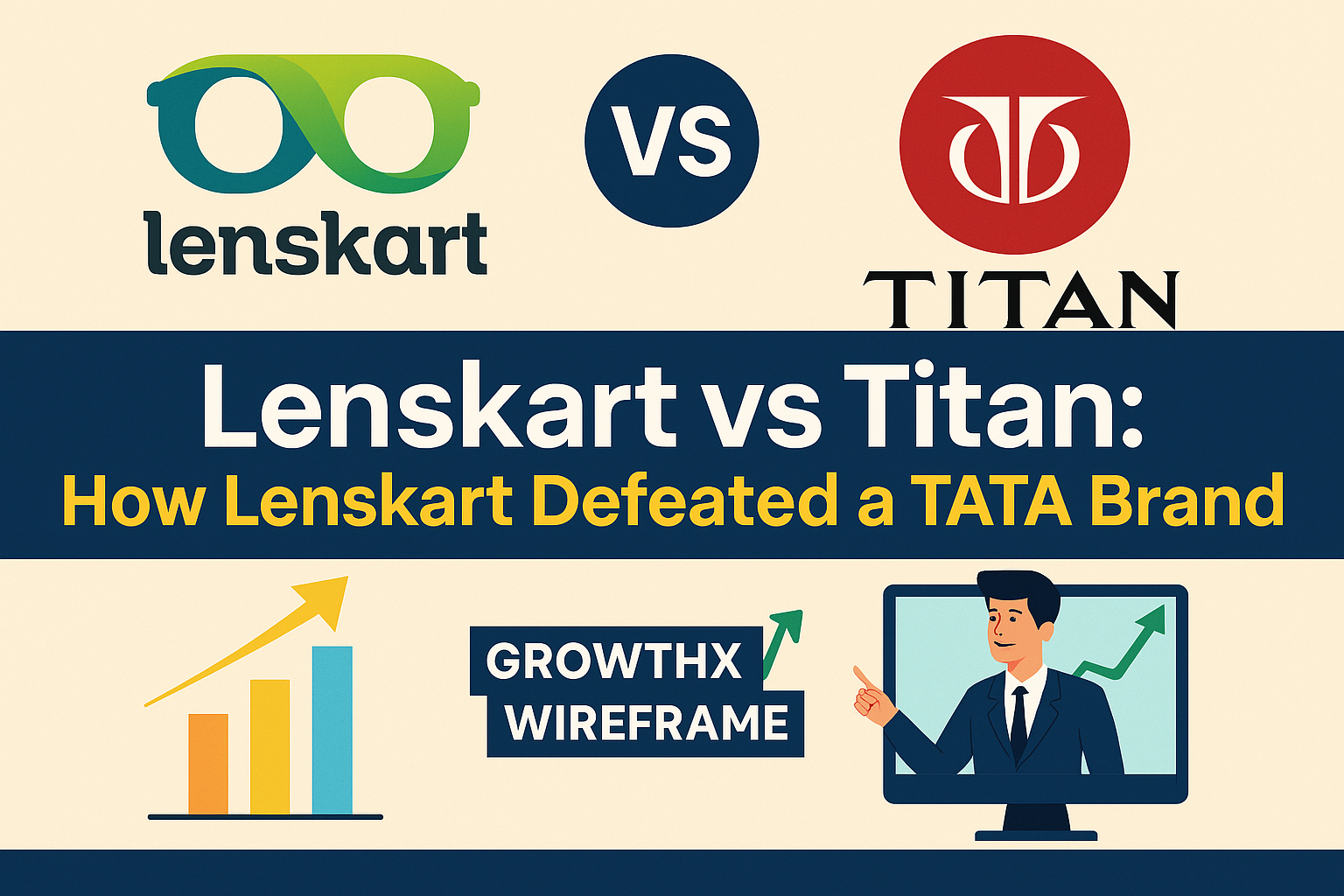Introduction: A Small Investment That Sparked a Giant Rivalry
In 2016, Ratan Tata made a small investment in a growing eyewear startup. Little did he know, this company would not only become one of his biggest competitors but also grow 5x bigger than a brand from the mighty House of Tatas themselves.
This is the first story in our new profitable startup series , We’ll go deep into learning how Lenskart became the eyewear market leader—despite starting 3 years later than Titan Eyeplus—now owning 5x of Titan’s entire market segment.
The Eyewear Landscape in 2010: An Unorganized Space
The year is 2010. At this time, most of the eyewear space in India was unorganized. No one was thinking of purchasing brand-new spectacles online. Most Indians relied on their nearest local optical shop.
Even today, more than 70% of the eyewear market share is still owned by the unorganized sector.
Peyush Bansal’s Journey: From Microsoft to Eyewear
Peyush Bansal, the founder, was not an expert in the optical space. He was an electrical engineer working at Microsoft in the USA. Inspired by a visit to Bill Gates’ house, he returned to India to start something impactful.
His early ventures included SearchMyCampus and Flyer.com, which evolved into Lenskart after meeting co-founders Amit and Sumeet. Together, they founded Valyoo Technologies and eventually narrowed their focus to Lenskart, seeing a massive opportunity in the branded eyewear space.
The Shift to Lenskart: A Brand-Building Opportunity
There was no big brand in the optical space, and Titan Eyeplus had failed to capture this space with style. In 2010, the Lenskart team went all in, taking on Titan Eyeplus, then India’s largest eyewear retail chain.
Lenskart’s 4 Key Wins Over Titan
1. Accessibility Problem
India is known as the blind capital of the world, with 40% of the world’s visually impaired living here. Lenskart had to solve the distribution challenge first.
- Omni-channel strategy: Combined physical and digital channels.
- Investor support: Backed by big names like Ratan Tata, IFC, Azim Premji, and SoftBank’s Vision Fund.
- Store growth: 2,000+ stores across 200+ cities, compared to Titan Eyeplus’s 1,000 stores.
- Tech-rich in-store experience: Virtual try-ons and polite staff created a premium experience.
- Online innovations: First to launch an app in 2017 with features like virtual trials, home eye checkups, free home trials, fast delivery, and repairs.
- Referral program: Viral strategy through phone contact sync yielded a database of 200M customers in just 6 months.
2. Affordability Problem
Peyush aimed to build the Maruti of India’s eyewear space—affordable yet premium-feeling.
- Value-based pricing: Frames starting from ₹500 attracted masses.
- Smart upselling: Anti-glare, anti-blue light lenses, and Gold Membership.
- Sticky strategy: Membership created loyal repeat customers.
- Standardized pricing: Built massive consumer trust—an area where Titan fell short.
3. Awareness and Brand Building
Lenskart didn’t just market eyewear—it made it fashionable.
- In-house brands: Vincent Chase and John Jacobs led revenue.
- Brand strategy inspired by Tata’s own playbook: Separate brand identities like Westside and Zudio.
- Aspirational advertising: Eyewear as fashion, not necessity.
- Influencer marketing: Blue Cut trend and celebrity campaigns with Karan Johar and Peyush Bansal himself.
- Shark Tank fame: Peyush’s appearance made him and Lenskart household names.
4. Unit Economics and Operational Excellence
At scale, managing inventory is hard, but Lenskart used AI to its advantage.
- Barcode tracking and AI integration: Monitored everything from stock to regional trends.
- Smart inventory management: Automated replenishment and store-level placement optimization.
- Factory automation: Built one of the world’s largest automated eyewear manufacturing units.
- Global expansion: 500 stores outside India post-acquisition of Japanese brand OWNDAYS.
Conclusion: The Power of Aggressive Thinking and Execution
If there’s one major difference between Titan and Lenskart, it’s mindset. Peyush Bansal’s big thinking, strategic aggressiveness, and relentless customer focus gave Lenskart a dominant 25% market share—five times that of Titan’s entire eyewear division.
Titan’s eyewear business contributes just 2% to its overall revenue, possibly explaining its lack of urgency. Meanwhile, Lenskart continues to grow rapidly with innovation and smart execution.
FAQs
Q1: Why did Lenskart succeed over Titan Eyeplus?
Lenskart solved key problems like accessibility, affordability, brand awareness, and operational efficiency—areas where Titan lagged.
Q2: What made Lenskart’s distribution model unique?
Its omni-channel strategy with both offline stores and a powerful digital platform, including a mobile app and virtual try-ons.
Q3: How did Lenskart manage to keep prices low but still feel premium?
They used value-based pricing and offered premium in-store and online experiences while making money on lenses, not frames.
Q4: Is Peyush Bansal still involved with Lenskart?
Yes, and his role as a Shark Tank India judge has only added to Lenskart’s brand visibility.
Q5: What role did technology play in Lenskart’s growth?
From AI-driven inventory management to tech-enabled in-store trials and advanced manufacturing, tech is core to Lenskart’s efficiency and scale.










